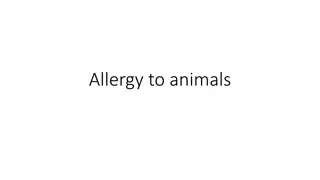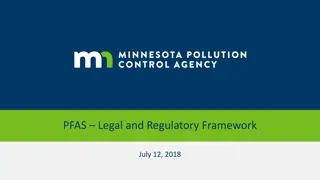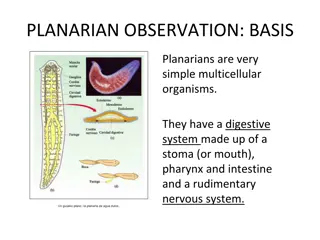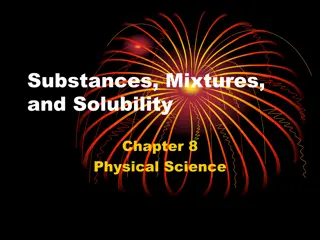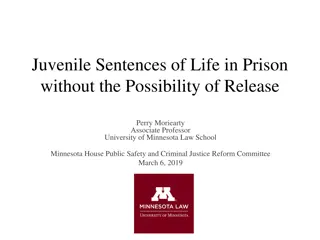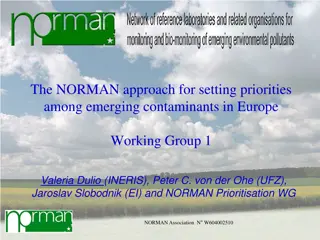Understanding Spirits and Their Uses in Therapeutics and Flavoring
Spirits, also known as essences, are alcoholic or hydro-alcoholic solutions containing volatile substances. They can be classified based on therapeutic or flavoring purposes. These solutions are prepared by distillation or dissolving volatile substances in alcohol, with varying alcohol content. Spir
4 views • 17 slides
How to Increase Student Engagement with Unusual Methods ,Strange Ideas ,and Pseudoscience
Engage students in a unique way with a Truth or Myth game where they stand if correct and sit if wrong. Featuring strange facts like cigarettes for asthma, and the banned history of Donald Duck comics, this interactive approach boosts participation and learning while adding an element of fun to the
3 views • 37 slides
Understanding Mixtures and Separation Techniques
Explore the concepts of mixtures and separation, from the definition of dominant and recessive alleles to the advantages of electron microscopes. Learn about identifying pure substances, differences between pure and impure substances, and techniques like filtration and crystallization for separation
0 views • 19 slides
Understanding Movement of Substances Through Cell Membrane
Substances enter and leave cells through diffusion and osmosis processes, driven by concentration gradients. The cell membrane plays a crucial role in selectively allowing substances to pass, ensuring cell survival. Osmosis can be demonstrated using Visking tubing, showing water molecules moving whi
0 views • 15 slides
Understanding Cell Membrane Transport: Diffusion and Facilitated Diffusion
Cell membrane transport plays a crucial role in maintaining cellular functions by regulating the movement of substances across the membrane. Diffusion, a passive transport process, allows molecules to move from areas of high concentration to low concentration without energy expenditure. Within diffu
1 views • 20 slides
Understanding Doping and Anti-Doping Rule Violations
Doping refers to the occurrence of various violations outlined in the World Anti-Doping Code, leading to Anti-Doping Rule Violations (ADRVs). Athletes are accountable for any prohibited substances found in their system, whether consumed knowingly or unknowingly. The list of banned substances is dete
2 views • 6 slides
Ear Cropping: Overview, Procedure, and Legal Status in Veterinary Practice
Ear cropping is the surgical procedure of removing part or all of a dog's pinnae or ear flap. While banned in many countries, it remains legal in specific breeds for certain purposes. This detailed guide covers the introduction, indications, age requirements, surgical process, post-operative care, a
0 views • 14 slides
Understanding New Psychoactive Substances (NPS) and Their Categories
New Psychoactive Substances (NPS) are substances of abuse not regulated by international drug conventions, posing significant public health risks. These substances can fall under categories like synthetic cannabinoids, stimulants, hallucinogens, and depressants, each with unique risks and effects. S
0 views • 11 slides
Understanding the Outer Space Treaty and the Lotus Principle
The Outer Space Treaty, comprising Articles I and II, establishes regulations on the exploration and use of outer space, emphasizing the benefit of all countries and free access to celestial bodies. The Lotus Principle, illustrated by the S.S. Lotus case, highlights that actions not explicitly banne
1 views • 4 slides
Understanding Antigens and Immunogens: Types and Properties
Antigens are substances that stimulate the production of antibodies in the body, exhibiting specificity in immune reactions. They interact with immune response products like antibodies, BCRs, and TCRs. Immunogens induce detectable immune responses, leading to antibody production or T cell activation
1 views • 30 slides
Exploring Current Social Issues and Persuasive Writing
Discover how to craft a compelling Higher Persuasive Folio essay by brainstorming persuasive topics and diving into current interesting issues. Avoid banned topics and focus on honing persuasive techniques for a successful essay.
2 views • 36 slides
Quantifying Substances in Mixtures Using Gas Chromatography
Gas chromatography is a precise method to quantify substances in mixtures, essential for various applications like food quality analysis, blood alcohol content testing, and developing green energy technologies. By accurately determining the identity and quantity of substances, such as pesticides in
1 views • 29 slides
Understanding Doping Testing in Competitive Sports
Doping in sports involves the use of banned performance-enhancing drugs by athletes, and testing for doping is a crucial aspect of ensuring fair competition. There are in-competition tests conducted during events and out-of-competition tests targeting various substances. Testing involves collecting
1 views • 20 slides
Understanding Allergies to Animals and Living Organisms
Allergies to animals and living organisms are a result of specific immune processes triggered by allergenic substances like proteins and peptides. This allergic response can be caused by various animal proteins such as dog allergens Can f.1, Can f.2, and Can f.3, and cat allergen Fel d1. The represe
1 views • 10 slides
Trends in New Psychoactive Substances Seizures and Use
Seizures of both plant-based and synthetic New Psychoactive Substances (NPS) declined in 2018, along with a decrease in global seizures of khat and fluctuations in the use of NPS. Legislation on substances like mephedrone led to a decline in their use, while the use of ketamine increased. NPS use va
0 views • 8 slides
NCAA Drug Testing Program and Nutritional Supplement Education
The NCAA emphasizes a food-first approach and cautions against the use of nutritional or dietary supplements due to the risk of contamination with banned substances. Student-athletes are advised to consult designated individuals before using any supplements as they may not be well-regulated. The NCA
0 views • 7 slides
A Year in the Life of a Coptic Peasant: Farming, Festivals, and More!
Explore the agricultural calendar of a Coptic peasant through the eyes of thirteenth-century chroniclers as they navigate farming tasks, festive celebrations, and governmental dealings. From seed collection to tax submissions, experience the rituals, traditions, and challenges faced by peasants in a
0 views • 29 slides
Examining Section 43 of the Criminal Code: The Debate on Corporal Punishment in Schools
Section 43 of the Criminal Code, known as the "Spanking Law," justifies the use of force for correction by teachers, parents, or guardians towards children under their care. This provision has historical roots and has sparked debates on corporal punishment in schools globally. The article explores t
2 views • 43 slides
Analyzing Chapter 1 of Animal Farm: Characters, Impressions, and Banned Behaviors
In Chapter 1 of Animal Farm, we are introduced to various characters such as Old Major, Mr. Jones, and different animals on the farm. Orwell uses language to portray each character's qualities and roles. The chapter focuses on Old Major's speech about revolution and equality, leading to the animals
1 views • 39 slides
Pure Substances vs. Mixtures: Characteristics and Differences
Pure substances have a fixed composition and distinct properties, while mixtures vary in composition and properties. Pure substances cannot be separated into simpler substances by physical methods, whereas mixtures can be. This article explores the characteristics, distinctions, and examples of pure
0 views • 13 slides
Overview of PFAS Legal and Regulatory Framework
This document outlines the legal and regulatory framework surrounding PFAS (per- and polyfluoroalkyl substances), including hazardous waste designation, historical context at 3M sites, and the definition of hazardous substances and waste according to Minnesota statutes. It also discusses the potenti
0 views • 19 slides
Reception and Criticism of "Huckleberry Finn" in the 19th Century
Huckleberry Finn" faced a mix of reception in the 19th century, with some areas praising it while others criticized its language, humor, and moral tone. The book was banned in Concord but gained popularity in other regions, with critics highlighting its depiction of Southern life along the Mississip
0 views • 17 slides
General Knowledge Quiz on Science, History, and Geography
Test your knowledge with this quiz covering topics like Nobel Prize winners, chemical formulas, color blindness, international organizations, sports events, beauty pageants, and banned pesticides. Challenge yourself and learn fun facts along the way!
0 views • 70 slides
Understanding NCAA Drug Testing Regulations for Student-Athletes
Explore important information about drug testing in NCAA, including banned substances, testing protocols, consequences of positive tests, and the responsibility of student-athletes. Learn about the classes of banned drugs, examples, and resources for waivers when needed.
0 views • 12 slides
Planarian Observation: Nervous System Activity Study
Planarian Observation involves studying the effects of different substances on a planarian's nervous system. Through remote laboratory experiments, observations are made on the movement of planarians in various solutions compared to a control solution. Results are analyzed to determine the effects o
0 views • 7 slides
Understanding Substances, Mixtures, and Solubility in Physical Science
Explore the concepts of substances, mixtures, and solubility in Physical Science with a detailed explanation of solutions, types of mixtures, and the importance of understanding these in everyday life. Discover the differences between atoms, elements, pure substances, and mixtures, and learn about h
0 views • 81 slides
Laboratory Safety Guidelines and Regulations at UCLA Chemistry Department
Stringent safety measures and regulations have been implemented at UCLA Chemistry Department following recent accidents. The enforcement of safety rules includes strict PPE requirements, banned use of certain chemicals, and adherence to a specific dress code. The policy emphasizes the importance of
0 views • 8 slides
Understanding pH Scale and Acidic Substances
Explore the pH scale and identify acidic substances by placing them correctly. Understand the acidity levels of common substances like water, orange juice, stomach acid, baking soda, and drain opener. Test your knowledge with interactive images depicting pH levels.
0 views • 8 slides
Common Dorm Inspection Findings: Safety Violations and Prohibited Items
Discover common safety violations and prohibited items found during dorm inspections, including issues with electrical setups, covered smoke detectors, extension cords, power strips, trash disposal, air fresheners, and banned appliances like industrial freezers. Stay compliant with regulations to en
0 views • 7 slides
Juvenile Sentencing Laws: Updates and Legislative Schemes Across States
The information provided discusses juvenile sentencing laws, emphasizing life imprisonment without parole and the changes being made at the state level. It covers amendments required after Miller v. Alabama, states that have not made changes, states that have banned juvenile life sentences without r
0 views • 6 slides
Quality Issues in Clinical Trial Materials: CMC Review by Dr. Dorota Matecka
Clinical trial materials undergo Chemistry, Manufacturing, and Controls (CMC) review to ensure pharmaceutical quality. This process includes assessing safety concerns, impurities, and specifications, along with other CMC considerations. Pharmaceutical quality encompasses the suitability, identity, s
0 views • 41 slides
Prioritization of Emerging Contaminants in Europe
The NORMAN approach focuses on setting priorities among emerging contaminants in Europe by selecting over 700 substances based on expert judgment and scientific literature citations. The prioritization scheme specifically designed for emerging substances involves assessing knowledge gaps and necessa
0 views • 17 slides
NCAA Drug Testing and Banned Substances Guidelines
The NCAA annually disseminates a list of banned drug classes and provides drug education to student-athletes, including mid-year transfers. Drug testing programs focus on prevention and safety, with sanctions in place to uphold competitive balance. Testing includes steroids, stimulants, and recreati
0 views • 9 slides
Exothermic and Endothermic Reactions of Different Substances
Learn about the concepts of exothermic and endothermic reactions, featuring specific substances like sodium hydroxide, lithium nitrate, ammonium nitrate, crystalline ammonium nitrate, and potassium bromide. Discover their properties, uses, and how they interact with water. Explore how these reaction
0 views • 5 slides
Understanding Properties of Matter in the Matter and Change Unit
Exploring matter, mass, weight, volume, and states of matter in the context of physical properties and compositions of substances. Discover how substances differ, the importance of uniform composition in materials, and the distinction between substances and mixtures.
0 views • 23 slides
The Risks of Food Additives: A Comprehensive Overview
Food additives play a significant role in enhancing and preserving food products, but they also come with potential health risks. This research project delves into the impact of food additives, highlighting concerning additives like brominated vegetable oil (BVO) and monosodium glutamate. The study
0 views • 9 slides
Procedures and Management of Pesticide Registration in Nepal
This content provides detailed information on the registration procedures, management, and regulation of pesticides in Nepal. It covers the registration method, advantages of analogous registration, banned pesticides list, types of pesticides, and essential documentation requirements for pesticide r
0 views • 43 slides
New Evidence for Five Synthetic Chemicals Reported by NILU
Evidence for five synthetic chemicals was reported by the Norwegian Institute for Air Research (NILU) at the 31st Meeting of the Parties to the Montreal Protocol. The research involved contributions from various experts and focused on new substances with ozone-depleting potential. The assessment pan
0 views • 8 slides
Understanding RoHS and China RoHS Compliance Regulations
RoHS and China RoHS are regulations that restrict the use of hazardous substances in electronic products to reduce environmental impact. RoHS targets substances like lead and mercury, while China RoHS is specific to pollution control in electronic products sold in China. Compliance with these regula
0 views • 18 slides
Chemical Substances Preparation Methods
Methods for preparing chemical substances including calculations for molarity, preparation of solutions from solid and liquid substances, and examples for preparing specific solutions like BaCl2 and CuSO4. Explained techniques for calculating the amount of solid substances needed to achieve a desire
0 views • 8 slides













